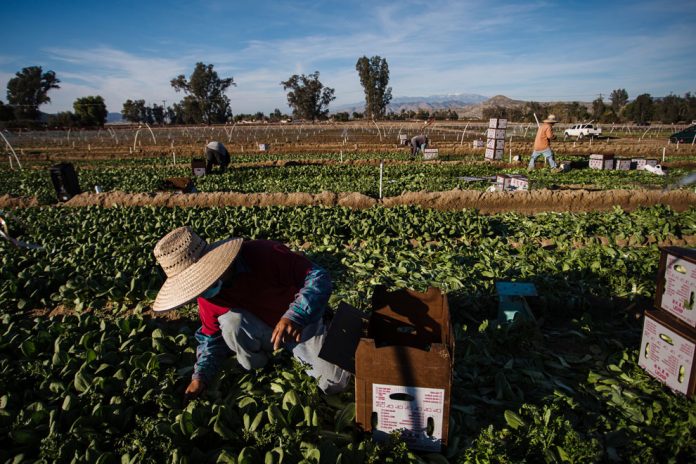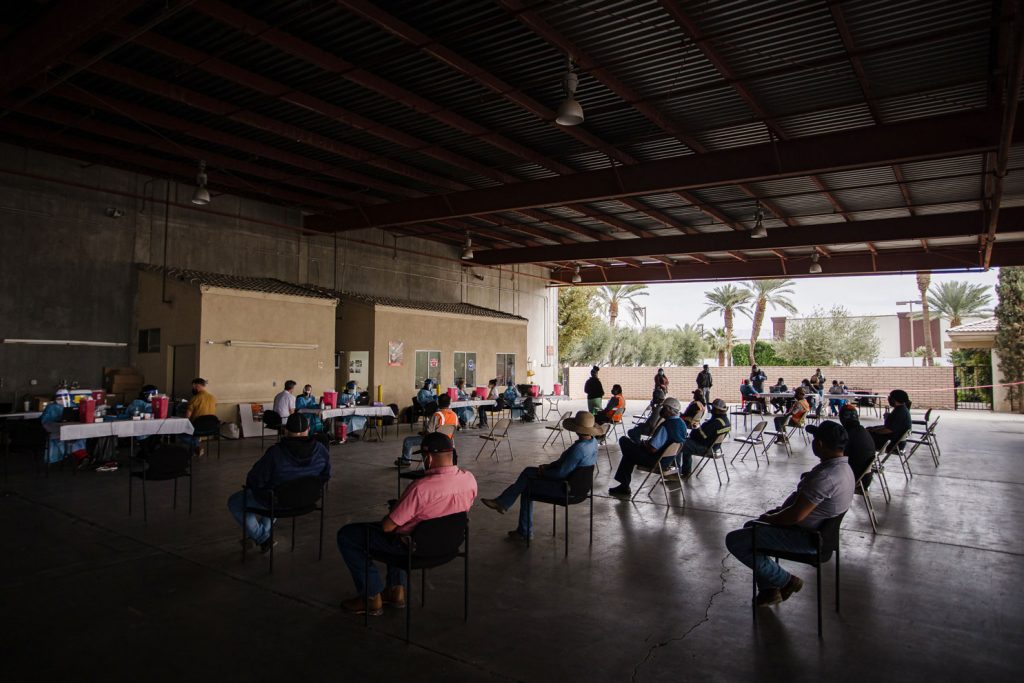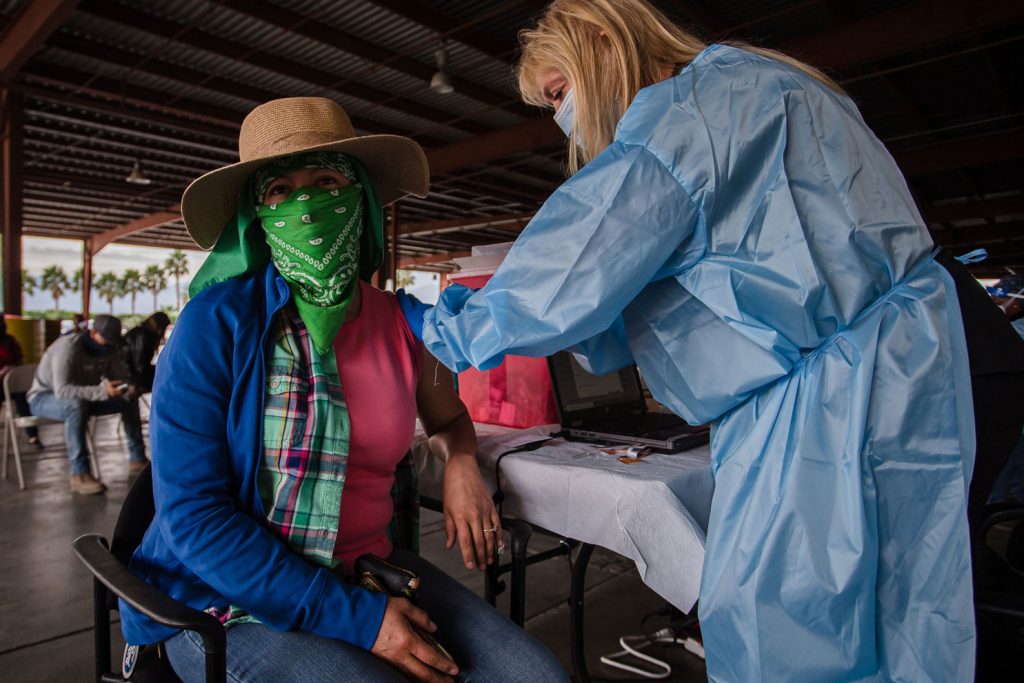
COACHELLA, Calif. — The sun-baked desert valley tucked behind the San Jacinto Mountains is best known for an annual music festival that draws 100,000 fans a day and a series of lush, oasis resort towns where well-heeled snowbirds go to golf, sunbathe and party. But just beyond the turquoise swimming pools of Palm Springs, more than 10,000 farmworkers harvest some of the country’s largest crops of date palms, vegetables and fruits.
Mainly immigrants in the country illegally, they have borne the brunt of the coronavirus pandemic in California: In some areas, up to 40% of the workers tested for the virus had positive results. The Rev. Francisco Gómez at Our Lady of Soledad church in Coachella said his parish had been averaging 10 burials a week. “You’re talking about an apocalyptic situation,” he said.
Ending the virus’ rampage through farm country has been one of the nation’s biggest challenges. Unauthorized immigrants are notoriously wary of registering for government programs or flocking to public vaccination sites, and the idea of offering the COVID-19 vaccine to immigrants who are in the country illegally ahead of other Americans has spurred debate among some Republican members of Congress.
But a landmark effort is underway across the Coachella Valley to bring the vaccine directly into the fields. Thousands of farmworkers are being pulled into pop-up vaccination clinics hosted by growers and run by the county Health Department.
Riverside County is the first in the nation to prioritize farmworkers for vaccination, regardless of their age and health conditions, on a large scale. But public health researchers say such programs will need to expand significantly to have any chance of ending one of the biggest threats to the stability of the country’s food supply.
Hundreds of coronavirus outbreaks have crippled the workforce on farms and in food processing centers across the country. Researchers from Purdue University estimate that about 500,000 agricultural workers have tested positive for the virus and at least 9,000 have died from it.
In the Coachella Valley, the vaccination program, which began in January, is the culmination of a monthslong effort to educate farmworkers about COVID-19, bringing testing close to their workplaces and encouraging them to stay home if they contract the virus.
On breaks from bunching scallions, harvesting artichokes and pruning grapevines, the workers on a recent morning trickled into an open-air warehouse to receive the first dose of the Pfizer vaccine.
They were spared the frustrating online registration process that most Californians must navigate and the hourslong waits that were typical at mass vaccination sites. Once they agreed to be immunized, an employer or organizer scheduled their appointments. Then, all they had to do was show up.
Rosa Torres, who packs dates, said she never imagined it could be so simple. “God answered my prayers,” said Torres, 49, an immigrant from Mexico, who was resplendent in matching lime-green shirt, wool cap and mask to mark the occasion.
A single mother, she said she could not afford to get sick and miss work.
“As soon as we got word vaccines were going to be available, we were making plans,” said Janell Percy, executive director of Growing Coachella Valley, a farmer group that is working with the Health Department. Percy spends frenetic days juggling calls between the county about vaccine availability and growers who inform her of the number of vaccines needed to cover their crews.

The challenges to getting farmworkers vaccinated go well beyond worries about their immigration status. The odds of being able to sign up for a vaccine online are low in a population that often lacks broadband access and faces language barriers. Many cannot easily reach vaccination sites in urban areas because they do not have reliable transportation or the ability to leave work in the middle of the day.
“Farmworkers are living in a reality that is foreign to most of us, and they are invisible to most of us, but they produce billions of dollars in food distributed across the United States,” said Conrado Bárzaga, chief executive of the Desert Healthcare District.
In March 2020, the federal government designated farmworkers as essential — a status that enabled them to continue working under stay-at-home orders but also put them at heightened risk of getting the virus.
Policymakers have struggled with how to protect them. The Centers for Disease Control and Prevention has advised giving agricultural workers early access to the vaccine, but states have taken a range of approaches.
Most have not yet started vaccinating agricultural workers, although many have identified them as a priority population. Most have prioritized people age 65 or older, and the average age of farmworkers is 39, with more than half under 44.
In California, several counties hope in March to expand eligibility to the entire agricultural workforce. Colorado, Idaho, Michigan and Wisconsin are among states that have said they intend to start vaccinating farmworkers in the coming weeks.
But other states have taken steps that could discourage workers from coming forward.
In Florida, a citrus powerhouse, people must prove residency to get a vaccine, a requirement that tends to deter unauthorized immigrants. Some pharmacies in Georgia, where people older than 65 are currently eligible for vaccines, have turned away immigrants unable to show a Social Security number. In Nebraska, where immigrants are the backbone of the large meatpacking industry, people without legal status will be vaccinated last, officials said.
In Riverside County, farmworker advocates and growers have been fielding calls from across the country about the vaccination effort, which is considered a model for how to administer vaccines to this population.
“It’s not just that they prioritized farmworkers — they developed a comprehensive, innovative strategy to ensure vaccine access and acceptance in farmworker communities,” said Alexis Guild, director of health policy at Farmworker Justice, a national advocacy organization.
Gov. Gavin Newsom, after a visit to a Coachella pop-up site on Feb. 17, announced that California would make 34,000 vaccines available to farmworkers in the Central Valley, the state’s agricultural heartland. “What this county has done no other county in the state had done,” he said. “We need to replicate this program all up and down the state of California.”
But some in Riverside County, which stretches from working-class Los Angeles exurbs to the Salton Sea, have questioned whether farmworkers should be at the front of the line.
On a recent evening in Beaumont, about a 30-minute drive from the Coachella Valley, people who had snagged appointments for vaccines through the process available to most California residents — mainly over 65 — idled in their cars for hours in the parking lot of a local middle school.
David Huetten, 73, said those confined to wheelchairs in his retirement community had been unable to reach vaccination events like this one. “When you have seniors and teachers who haven’t been vaccinated, I wouldn’t put farmworkers at the top of the list,” he said.

Like many Americans, some farmworkers worry the vaccine is not safe, because disinformation has proliferated on social media. Others fear that being vaccinated could expose them to immigration enforcement.
Prime Time International, the nation’s largest grower of bell peppers, invited workers to register for the vaccine in January, and “the first question was, ‘Is immigration going to be there?’” recalled Garrett Cardilino, director of field operations for the company.
To assuage those fears, Riverside County enlisted grassroots organizations to reach out to farmworkers and reassure them.
“There is no chip to track you; there is no negative effect; you don’t lose your fertility,” Montserrat Gomez, an educator with TODEC, a legal-aid nonprofit organization that serves immigrants, told a group of about 30 workers in masks gathered by a spinach field in the town of Winchester.
“The vaccine is now available for you,” she said. “Many people wish they had this opportunity.”
Copyright 2021 The New York Times Company













